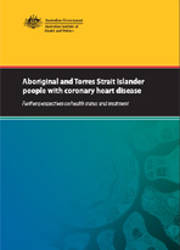Summary
The issues
It is well known that Aboriginal and Torres Strait Islander people have much higher death rates from ‘major coronary events’ (often known as heart attacks) than other Australians. But what has not been known is whether this is because they: are much more likely to have a heart attack in the first place; have much lower survival; are more complex cases; or receive less treatment— or some combination of these and other factors.
The study
This study used 2002–2003 hospital and mortality records to examine some of these questions for Indigenous Australians. Data were considered adequate for inclusion in the analysis from Queensland, Western Australia, South Australia and the Northern Territory. The study is the first of this scale to take aspects of Indigenous case complexity into account and to measure Indigenous hospital procedure rates in terms of need.
The findings
The study found that, compared with other Australians, Aboriginal and Torres Strait Islander people were considerably more likely to suffer a heart attack, to die from it without being admitted to hospital, and to die from it if admitted to hospital. In hospital they were less likely to receive key medical investigations or common procedures such as coronary bypass surgery or angioplasty.
It was also found that Indigenous Australians admitted to hospital for coronary heart disease (CHD) were more complex cases, but this does not appear to account for differences in procedure rates.
Specifically, compared with other Australians, Indigenous Australians had:
- 3 times the rate of major coronary events such as heart attack
- 1.4 times the out-of-hospital death rate from CHD.
and when in hospital:
- more than twice the in-hospital CHD death rate
- a 40% lower rate of being investigated by angiography
- a 40% lower rate of coronary angioplasty or stent procedures
- a 20% lower rate of coronary bypass surgery.
The study also outlines some limitations in its underlying data and some other possible reasons for the findings that could not be explored in this report.
The message
Even allowing for the study’s limitations, the disparities it found still show a strong pattern that expands the picture of Indigenous disadvantage and poor health. They make a compelling case that ways must be found to eliminate the disparities.
Preliminary material (145K PDF): List of tables; List of figures; Acknowledgments
Introduction (287K PDF)
Methods
- Data sources
- Data quality
- Health measures
- Analytical methods
Incidence of major coronary events and case fatality
- Incidence of major coronary events
- Case fatality
Coronary procedures in hospital
- Use of procedures
Case complexity
- Comorbidities
- Procedure use according to complexity
Discussion
- Incidence and case fatality
- Coronary procedures in hospital
- Case complexity
- Other issues which may influence procedure rates
- Data issues
- Conclusion
Appendix A: Methods (173K PDF)
Appendix B: Statistical tables
End matter: Glossary; References



